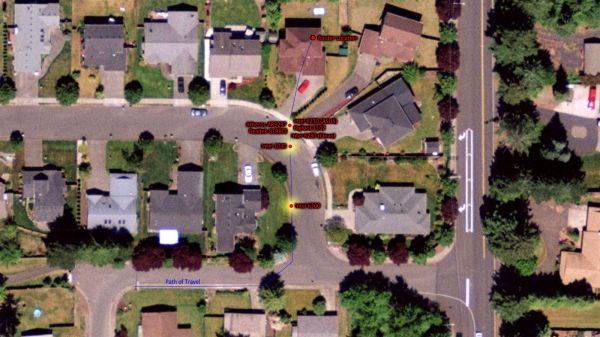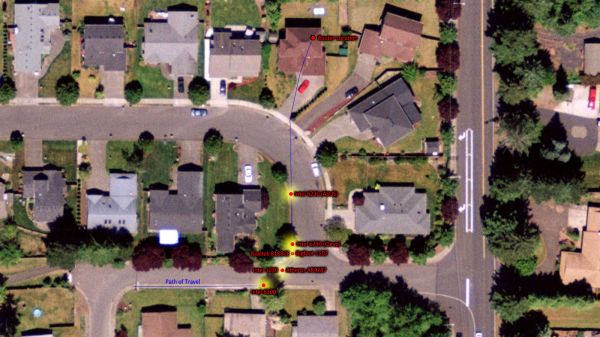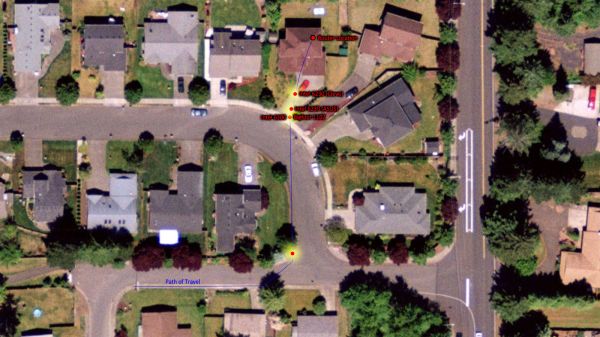Bigfoot’s Killer-N 1102 Wireless Networking vs. the World
by Jarred Walton on August 10, 2011 10:38 AM ESTTesting Signal Range
Throughput and latency are only two elements of wireless performance. Another important metric is how far a device can be from the router/access point before it drops the signal. For the Linksys E4200 router, we tested 2.4GHz and 5GHz performance with the other radio disabled (since we didn’t want the 5GHz capable laptops switching to 2.4GHz when the signal got weak). The routers were located in my office (one at a time) and I proceeded to walk out the front door with each laptop, closing the metal door behind me. It’s about 40 feet from the router to the front door (not in a direct line), and then I walked down the driveway and out into the street. I’ve created plots showing where I walked and how far I could go with each router and laptop combination. We’ll start with the Netgear results.
The vast majority of the laptops started having connection issues just past the end of my driveway. In fact, only two laptops did noticeably better, and one of those was only just barely better. The Intel 1030 maintained a connection about 20 feet further out than the other wireless devices, though throughput was understandably low (less than 5Mbps). The clear winner however is the Intel 6300. The third stream is almost certainly helping here with MRC, and perhaps the antenna and/or drivers have something to do with the performance as well. Regardless of the reason, the 6300 holds onto the wireless signal a good 60 feet farther than the 1030, and about 80 feet farther than the other wireless devices.
Moving to the Linksys E4200 and using the 2.4GHz radio, the results are substantially better than with the Netgear, thanks to a more powerful radio. Intel’s 6300 again goes the farthest before dropping out, reaching over 200 feet, likely thanks to the three spatial streams/antenna chains. The Atheros and Intel 1030 place second, just ~15 feet shy of the 6300, and Bigfoot’s 1102 and Realtek’s 8188CE are another ~15 feet behind the Atheros. Given the performance elsewhere, we weren’t particularly surprised to see Intel’s 6230 having the lowest coverage area, but it was a surprise to find that the ASUS K53E didn’t reach as far as the Clevo W150HR. Even though the K53E has worse coverage, keep in mind that it still works well in my entire yard and most of the neighboring houses—the latter point being good or bad, depending on whether you like sharing your wireless network.
When we shift over to a 5GHz signal, range drops significantly, providing even less coverage than the Netgear router. Higher frequency signals don’t propagate nearly as far, which can actually be beneficial for home environments—if all of my neighbors were using 5GHz wireless networks, I’d be lucky to see much less connect to any of them! This is one reason all the 5GHz capable cards perform so much better on a 5GHz network: lack of interference from neighboring networks (and microwaves, cordless phones, etc.). Of course, if you want a larger coverage area, even the worst result on 2.4GHz is about twice as far from the router as the best 5GHz result. Interesting to note is that in 5GHz testing, the Bigfoot 1102 actually has the best throughput out to near the end of my drive, pushing over 30Mbps until the last 5-10 feet. The cutoff point for 5GHz is really abrupt, and again that’s either good or bad depending on your intended use.
If reception at the limits of your wireless signal is important to you, the Intel 6300 appears to be the best bet (though potentially other 3x3:3 solutions might post similar results). However, we also need to consider throughput. Even though all of the devices technically maintained a 2.4GHz signal to the end of my driveway, I consider ~10Mbps of throughput to be the cutoff point for my purposes. In that case, right about where the red vehicle is parked is where I’d start getting irritated on the Netgear router, and maybe to the end of my driveway with the Linksys—except for the Intel 6300, which can go another 40 feet or so before dropping below 10Mbps. In general, even though some of the cards went farther before dropping the connection (or losing packets), throughput is much lower beyond the (metal) front door. All of the cards manage about 20-40Mbps inside the house, but close the front door and that quickly drops to 10-20Mbps. While that’s still faster than most Internet connections, latency starts to increase as well and periodic dropped packets become a concern.













52 Comments
View All Comments
JarredWalton - Wednesday, August 10, 2011 - link
I was estimating. I just paced it off, and walking (around corners) it's about 50 feet. In a direct line, it's more like 30 feet. I'll update the distances, though it's all very rough. (I don't have blueprints for the house, but it's about 2300 sqft with an upstairs and downstairs; corner to corner is about 50 feet I'm guessing. I'm revising the distances to be as accurate as possible, but for reference that red vehicle in the driveway is almost 20 feet long if that helps.theqat - Wednesday, August 10, 2011 - link
Any idea when we can expect the Pollux review? I'm trying to make a decision on a laptop fairly soon and I'd love to see what you guys think about it before I do so.Hrel - Wednesday, August 10, 2011 - link
I kept looking for a range test but didn't see it. Having an issue with my Clevo P150HM, had to send it back to cyberpowerpc. Got no wifi signal at all at public places like panera and starbucks. I kind need internet in those places. Huge part of the reason I even have a laptop. It has the Intel 6230 in it cause I need bluetooth.ggathagan - Wednesday, August 10, 2011 - link
Page 7? Entitled "Testing Signal Range"?Focher - Wednesday, August 10, 2011 - link
Once again, Bigfoot's product doesn't really offer anything of extra value to alternative products (personally, I think the UDP test results are wonky and it's unbelievable that a current wifi device would best wired gigabit Ethernet, let alone dominate to the extent that the test showed). You're better off getting a true 3x3:3 card, even if the current performance only matches the 1102. At worst, performance will stay the same. But there's at least a chance that the addition transmit and receive channels will enable improved performance with a firmware update. Sure, if the 1102 is the default card in a particular laptop then fine (although I'd still take the Intel 6300 over it) but I sure wouldn't pay any price premium for it unless it's an upgrade option to replaces some default low end device.neothe0ne - Wednesday, August 10, 2011 - link
yeah, Lenovo and HP are horrible companies. HP is even worse because all their consumer products force you on WiFi Link 1000 (their Bluetooth is offered in a separate chip). Most of the Probooks and Elitebooks and the Envies use Centrino 62xx cards, thankfully... but they're still whitelisted.Peroxyde - Wednesday, August 10, 2011 - link
Hi experts,Sorry for off topic question. Can you please recommend a good wireless router? I have heard of TP-Link 1043ND as being well rated. Is it really better than Linksys or DLink? Thanks in advance
jigglywiggly - Wednesday, August 10, 2011 - link
A LIL LATE FOR THIS ARTICLEI HAVE A CLEVO WITH A 6230
AAAAAAAAAAAAAAAAAAAAAAAAAAAAAAAAAAAAAAA
iamkyle - Thursday, August 11, 2011 - link
The majority of laptops can't even use this card thanks to the legalized monopolization of laptops via whitelists. That crap should be illegal.The_Laughing_Man - Thursday, August 11, 2011 - link
I think Bigfoot should sue those tier one laptop suppliers for anti-competitive practices.Whitelist should be illegal.
I have a brand new HP laptop, I can replace the WiFi card after booting and it works just fine. It is even in the same WiFi family that comes with the laptop and Windows uses the same set of drivers for both cards. But the notebook will not boot with newer dual-band card installed during start-up due to HP whit-list in their BIOS.
On top of that HP encrypts their BIOS such that is is very difficult to hack their BIOS to allow valid WiFi cards, not to mention other things.
HP doesn't even offer an upgrade to a dual-band WiFi card for this very expensive high-end notebook the DV7T, even if I was willing to pay them for it.
And Dell, Asus, Acer, and Sony all do the same thing.
They all need to be sued. And until they remove their whitelists, Bigfoot will be forced to have a very small market to sell their mini-pcie killer-n card to.